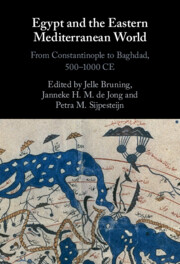Book contents
- Egypt and the Eastern Mediterranean World
- Egypt and the Eastern Mediterranean World
- Copyright page
- Contents
- Figures, Graphs, and Tables
- Notes on Contributors
- Notes on Transliteration, Names, and Dates
- Preface and Acknowledgments
- Additional material
- Introduction
- Part I Political and Administrative Connections
- Chapter 1 Egypt in the Age of Justinian: Connector or Disconnector?
- Chapter 2 At the Crossroads of Regional Settings: Egypt, 500–1000 CE
- Chapter 3 The Frontier Zone at the First Cataract before and at the Time of the Muslim Conquest (Fifth to Seventh Centuries)
- Chapter 4 Islamic Historiography on Early Muslim Relations with Nubia
- Chapter 5 Local Tradition and Imperial Legal Policy under the Umayyads: The Evolution of the Early Egyptian School of Law
- Chapter 6 Ibn Ṭūlūn’s Pacification Campaign: Sedition, Authority, and Empire in Abbasid Egypt
- Part II Economic Connections
- Part III Social and Cultural Connections
- Index
- References
Chapter 5 - Local Tradition and Imperial Legal Policy under the Umayyads: The Evolution of the Early Egyptian School of Law
from Part I - Political and Administrative Connections
Published online by Cambridge University Press: 01 December 2022
- Egypt and the Eastern Mediterranean World
- Egypt and the Eastern Mediterranean World
- Copyright page
- Contents
- Figures, Graphs, and Tables
- Notes on Contributors
- Notes on Transliteration, Names, and Dates
- Preface and Acknowledgments
- Additional material
- Introduction
- Part I Political and Administrative Connections
- Chapter 1 Egypt in the Age of Justinian: Connector or Disconnector?
- Chapter 2 At the Crossroads of Regional Settings: Egypt, 500–1000 CE
- Chapter 3 The Frontier Zone at the First Cataract before and at the Time of the Muslim Conquest (Fifth to Seventh Centuries)
- Chapter 4 Islamic Historiography on Early Muslim Relations with Nubia
- Chapter 5 Local Tradition and Imperial Legal Policy under the Umayyads: The Evolution of the Early Egyptian School of Law
- Chapter 6 Ibn Ṭūlūn’s Pacification Campaign: Sedition, Authority, and Empire in Abbasid Egypt
- Part II Economic Connections
- Part III Social and Cultural Connections
- Index
- References
Summary
The community of Egyptian jurists is best known from the second half of the eighth century, under the first Abbasids onwards, when their interactions with other provinces increased. The community’s most famous scholar, al-Layth b. Saʿd (d. 175/791), an early Abbasid jurist, maintained a correspondence with his alter ego in Medina, Mālik b. Anas (d. 179/795), with whom he debated legal doctrine. However, Egyptian jurists before 132/750 have been little studied.*Joseph Schacht maintains that Egypt did not develop any original school of law, and that its jurists followed the Medinan legal tradition. His conclusions, however, are not based on any in-depth study of the Egyptian milieu during the Umayyad period, but rather on the later writings of al-Shāfiʿī (d. 204/820).1 Yet, as I have shown in a previous study, al-Layth b. Saʿd both proclaimed his respect for the Medinan legal school and supported an autonomous Egyptian legal tradition, based on the jurisprudence of Companions who had taken part in the conquest of the province.
- Type
- Chapter
- Information
- Egypt and the Eastern Mediterranean WorldFrom Constantinople to Baghdad, 500-1000 CE, pp. 131 - 168Publisher: Cambridge University PressPrint publication year: 2022



